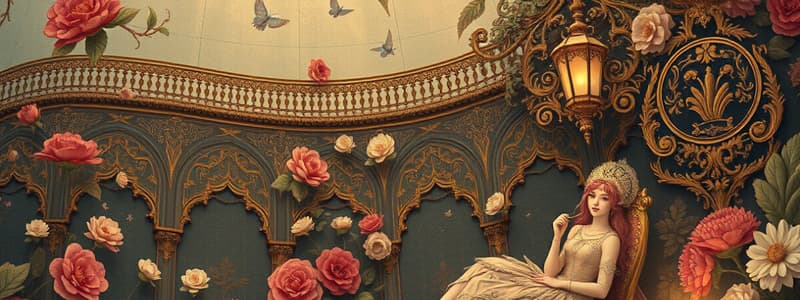Podcast
Questions and Answers
What does the term 'art' derive from in Italian?
What does the term 'art' derive from in Italian?
artis
According to Plato, what is art?
According to Plato, what is art?
- A means of communication
- The product of man's need to express himself
- That which brings life in harmony with the beauty of the world (correct)
- An attitude of spirit
Art is not influenced by culture.
Art is not influenced by culture.
False (B)
What is one of the natures of art?
What is one of the natures of art?
What does art as a creation imply?
What does art as a creation imply?
Art must be ___ or ___ to be appreciated.
Art must be ___ or ___ to be appreciated.
How is art related to beauty?
How is art related to beauty?
Match the following concepts related to art and nature:
Match the following concepts related to art and nature:
What personal functions does art serve?
What personal functions does art serve?
What are the physical functions of art?
What are the physical functions of art?
Flashcards are hidden until you start studying
Study Notes
Understanding Art
- Etymology: Derived from Latin "ars," Italian "artis," and Greek roots, emphasizing craftsmanship, skill, and the interplay of form and ideas.
- Definitions of Art:
- Plato: Art harmonizes life with world beauty.
- F. Zulueta: Art reflects human expression.
- John Dewey: Art is an attitude demanding personal satisfaction and reimagining material into significant forms.
Art Appreciation
- Definition: The capacity to interpret and enjoy man-made arts through experience, admiration, and understanding cultural contexts.
- Historical Context: Requires knowledge of art's evolution, societal influences, and cultural connections for deeper appreciation.
Natures of Art
- Ubiquity: Art exists in all environments, surrounding individuals everywhere.
- Expression and Communication: Serves as a medium to express thoughts and connect socially.
- Creation: Involves reordering existing materials into new forms, showcasing innovation.
- Perception and Experience: Requires engagement through sight and sound for full appreciation and entails intellectual comprehension.
- Art and Beauty: Art evokes pleasure in perception, highlighting aesthetic appeal.
- Comparison with Nature:
- Art: Man-made, artificial, fixed in form, needs enhancement.
- Nature: Naturally occurring, dynamic, and ever-changing.
Functions of Art
- Personal Function:
- Provides comfort, happiness, and convenience.
- Satisfies the need for personal expression.
- Enhances sensory perception through colors, forms, and designs.
- Physical Function:
- Addresses utilitarian needs with functional objects.
- Aims to enhance beauty in everyday-use items.
- Influences urban planning and community aesthetics.
Studying That Suits You
Use AI to generate personalized quizzes and flashcards to suit your learning preferences.


